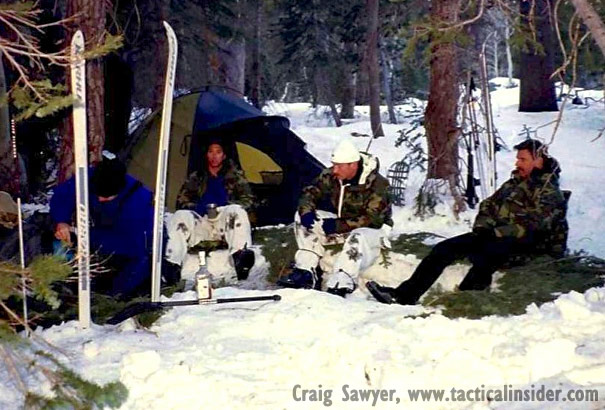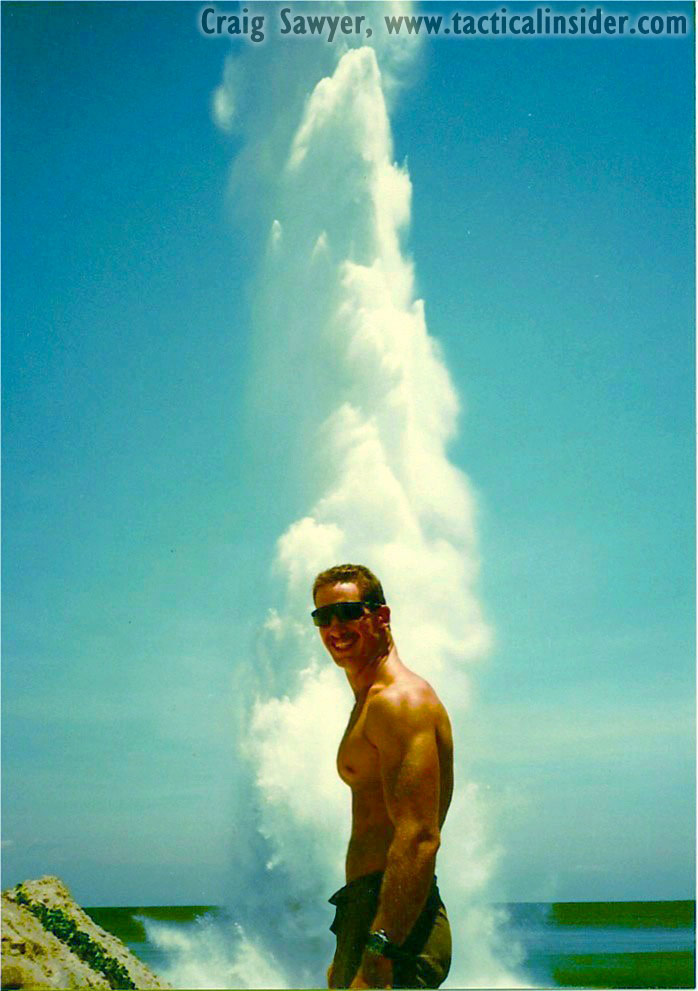Angelini Talks Gaming With DEVGRU Operator Craig Sawyer
Minimizing The Fog Of War Without A Mini-Map
Tom’s Hardware: Naturally, much of what happens during wartime, from confidential scenarios to the way special operations forces work together, simply cannot be used in games or movies. What aspects of your experiences can't be appropriately captured, either for national security reasons or because of purely technical limitations? I’ll admit to adrenaline rushes during action-packed game sequences, but surely it’s impossible to convey what your body experiences in combat.
Craig Sawyer: Well, we certainly wouldn't ever show unique mission capability options we haven't used yet, or that haven't been made known to our enemies. The precise way we shoot, move, and communicate should never be made known to our enemies. The good news is that those things wouldn't make the games better, anyway. There are plenty of creative options available to make games more realistic without drawing from the playbook real operators use to survive.
Let's face it, you'll have more fun playing through a title with certain aspects that defy reality than working through the application of a tourniquet to your buddy's arterial wound.
Tom’s Hardware: Conversely, games sometimes give us more information than you’re privy to on a battlefield. We’re accustomed to certain management aids, such as squad member positions on a mini-map. How do soldiers keep tabs on the men around them in the real-world, and is the emphasis on voice or signal communication? How do the elite forces reduce the fog of war?
Craig Sawyer: Well, there are lots of ways our soldiers keep up with each other in combat. Some of those have already been shown to the rest of the world in recent movies. The only way to effectively reduce the fog of war is to inoculate the troops to it. By that, I mean introduce those stressors into training until the subjects are more relaxed and efficient in a chaotic environment.
Let's take the civilian sport of skydiving as an example. When people jump out of a perfectly good airplane for the first time, their heart rate is often so fast that they experience multiple undesirable symptoms, including auditory exclusion, tunnel vision, loss of fine motor skills and dexterity, and impaired judgment. This overloaded sensation wanes with familiarization. By the time someone has thousands of jumps, they notice every little thing that happens during the experience. The first-timer often sees nothing but sky, ground, sky, ground, altimeter, sky, ground, sky ground. Ground! Altimeter? Yikes! Pull!
Tom’s Hardware: We also have the benefit of seemingly limitless endurance. Can you give our audience some idea of what it’d take to maintain the physical condition required to be combat-effective with a full equipment load-out? What would your daily routine entail?
Get Tom's Hardware's best news and in-depth reviews, straight to your inbox.
Craig Sawyer: Let's face it, even the most modern "lightweight" weapons, ammo, med kit, communications equipment, and navigational aids still add up to a heavy final load-out. Getting all that gear into enemy territory is no easy task. It requires extreme physical conditioning, especially when you consider that, once you get it there, you have to win a fight and get the heck out!
With that in mind, there is no specific routine for conditioning, other than the fact that conditioning, itself, must be routine. We break it up and challenge ourselves with every kind of physical demand we can think of: running, obstacle courses, swimming, weight lifting, calisthenics, and fighting. In the end, we have nobody to blame if we're in harm's way and have to perform, but are somehow not fit enough to pull off the big task. It could cost us our lives or the mission itself. So, we stay hard to avoid such a catastrophic scenario.
"The more you sweat in peace, the less you bleed in war!"
Current page: Minimizing The Fog Of War Without A Mini-Map
Prev Page The Importance Of OPSEC Next Page All Of The Gear A SEAL Could Want-
jaquith Very interesting article and special thanks to Craig Sawyer!Reply
We did not pursue questions that would violate OPSEC
Yeah, we wouldn't want another MoH overreaction.
The lack of a fatigue factor, even in fairly realistic first-person shooters, has always bothered me. Most titles allow you to sprint briefly before slowing down to a run, but you’re able to shoot, jump, and then, seconds later, sprint again. Is this something that needs to change in the next generation of games, or would "the real thing" be a total turn-off for a gamer?
Try Paintball. Otherwise VR with electric shock. Either way, IMO very few want total or close to realism in gaming other than theatrics. Listen, I've been shot by a 22mm that grazed off my knee taking-off a piece of meat -- getting welted-up from paintball's or electric shock is a cake walk.
Personally, I'm far from a SEAL (really far) but I like my guns, and my Glock 19 with a LaserMax will make folks think twice about leaving in a home invasion - it's there as fast as I can reach. The POF-USA P308-12-MRR 7.62mm NATO is indeed sweet and ain't cheap; just what every 'deer' hunter needs.
-
Pawessum16 Correction on page 2:Reply
Tom's Hardware: I think all gamers remember the Call of Duty: Modern Warfare 2 scene where you're a sniper in the top floor of a building in Chernobyl. As a real U.S. Navy SEAL sniper, how accurate is this experience?
I remember that so well that I know for a fact that it happened in the original Modern Warfare, ie COD4: Modern Warfare.....before they stopped the numbering.
And after finishing reading the article, I'd like to add that it was pretty great. To someone like me who doesn't know a thing about real world combat, it was very insightful, and Sawyer made some good points about the direction of the gaming industry in regards to shooters. -
Chewie Accuracy's my biggest problem with Crysis, to this day. I especially remember a point early in the first game where I like to lie down in the grass and take out the Norks manning MG emplacements that just can't seem to see me. The problem was, with the Assault Scope I was taking 3 or 4 shots to get a head shot on these guys. The reticle covered the whole head! I checked the range range with the visor, or binocs, or whatever, and got a range of 80m!Reply
Now, I'm no sniper dude, but I can get multiple 2 inch 5 round groups at 200 metres with the Steyr AUG, and that has a 1.5x optical scope. Also, no cool crysis suit to help. So at 80m, firing from prone, you bet your arse I can pick which eye to take out. But not in Crysis. Most of the other stuff about that group of games is cool, but the accuracy issue drives me nuts every time. -
army_ant7 ReplyTom’s Hardware: What is Sleep, Eat, and Lift?
Chris, I bet you were making your prayers and cringing already while he was saying that. :lol:
Craig Sawyer: Hey! Are you punking me, man!? Hah.
I'm kidding of course. :P But I know I would, knowing that guy could snap my neck with one hand! :lol:
That aside, a great read! I thank you and Mr. Sawyer there. :D I giggled at the thought of how ridiculous the things we do in games are, and imagined it in real life. Seeing those CoD (and others) commercials would make think they're silly now albeit still cool. :lol: -
US_Ranger Good article. I especially liked the part about posers. That shit always bothers me and I've run into my fair share of them as well.Reply
Sua Sponte Craig, good luck in your new endeavors. -
mapesdhs Thankyou so much for this article Chris! The most interesting piece I've read on any site forReply
a long time.
Best wishes & respect to Craig and all his colleagues.
Ian.
-
happyballz ChewieAccuracy's my biggest problem with Crysis, to this day. I especially remember a point early in the first game where I like to lie down in the grass and take out the Norks manning MG emplacements that just can't seem to see me. The problem was, with the Assault Scope I was taking 3 or 4 shots to get a head shot on these guys. The reticle covered the whole head! I checked the range range with the visor, or binocs, or whatever, and got a range of 80m!Now, I'm no sniper dude, but I can get multiple 2 inch 5 round groups at 200 metres with the Steyr AUG, and that has a 1.5x optical scope. Also, no cool crysis suit to help. So at 80m, firing from prone, you bet your arse I can pick which eye to take out. But not in Crysis. Most of the other stuff about that group of games is cool, but the accuracy issue drives me nuts every time.Reply
I personally participate in bolt-action rifle competitions up to 1000yards but...AUG A’s 1.5x optical scope with 2 inch groups at 200m? You better have used a fully locked bench rest for that...AKA you were just pressing the trigger and the bench was holding aim. Otherwise I really doubt your "consistent" 5 round groups; I have used A1's reticle 1.5x scope before, and after 100-150 yards the "donut" reticle covers too much to know where the true center is. So you either very lucky repeatedly or are over exaggerating a bit. -
mayankleoboy1 happyballzSo you either very lucky repeatedly or are over exaggerating a bit.Reply
Or he has practiced lots and lots more than you -
stevelord One of my favorite experts on Top Shot. Can't wait till the next season (which has been filming since September I believe.)Reply


